1. 前言
對于使用微控制器進(jìn)行產(chǎn)品開發(fā)的設(shè)計人員來說,因產(chǎn)品及功能升級,往往需要將一種微控制器替換成另一種微控制器,在保留既有功能的情況下增加新功能。為了更快地推出新產(chǎn)品,設(shè)計人員經(jīng)常要將應(yīng)用程序移植到新的微控制器。
本應(yīng)用筆記旨在幫助您快速將應(yīng)用程序從 STM32F10x 系列微控制器移植到 GD32E103 系列微控制器(基于 STM32F10x 標(biāo)準(zhǔn)庫 V3.5.0)。
GD32E103 和 STM32F10x 系列相比,考慮軟硬件兼容性,從 Flash 和 SRAM 容量,包括外設(shè)模塊的增強性能上來看,GD32E103 最接近 STM32F10x 互聯(lián)性。
開始前您需要安裝 GD32E103 關(guān)于 KEIL 或 IAR 的插件,在工程選項的器件條目中選擇 GD32E103對應(yīng)型號,添加 GD32E103 的 Flash 下載算法。
GD32E103 較 STM32F10x 具有以下優(yōu)點:
1、更高的主頻(120MHz VS 72MHz)
2、更高版本的內(nèi)核(Cortex M4 VS M3)
3、更低的功耗(Run Mode:28.6mA@120MHz VS 50mA@72MHz;Sleep Mode:20.8mA@120MHz VS 30mA@72MHz )
但需要注意的是,GD32E103 較 STM32F10x 少了 SDIO 功能,如果用戶使用到 SDIO 功能,從STM32F10x 到 GD32E103 的移植,顯然是不合適的。
2. 引腳兼容性
STM32F10x 與 GD32E103 在相同封裝下是 Pin To Pin 兼容的。但由于外設(shè)功能上的細(xì)微差別,兩者引腳定義有少許不同,如表 1 所示。注意:STM32F10x 外設(shè)編號從 1 開始,GD32E103 外設(shè)編號從 0 開始,且命名有差異。
表 1 STM32F10x 系列和 GD32E103 系列引腳區(qū)別
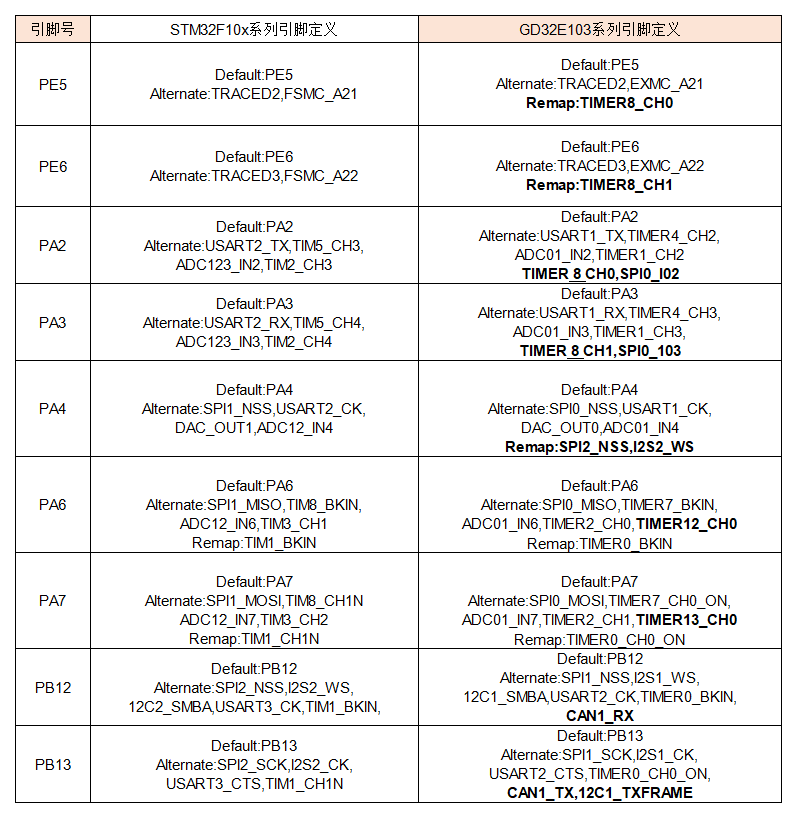
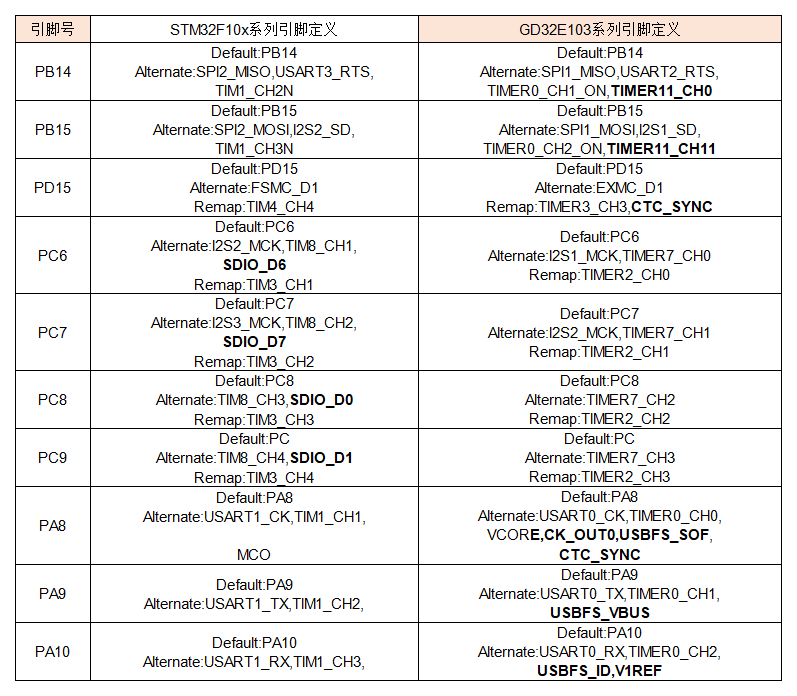
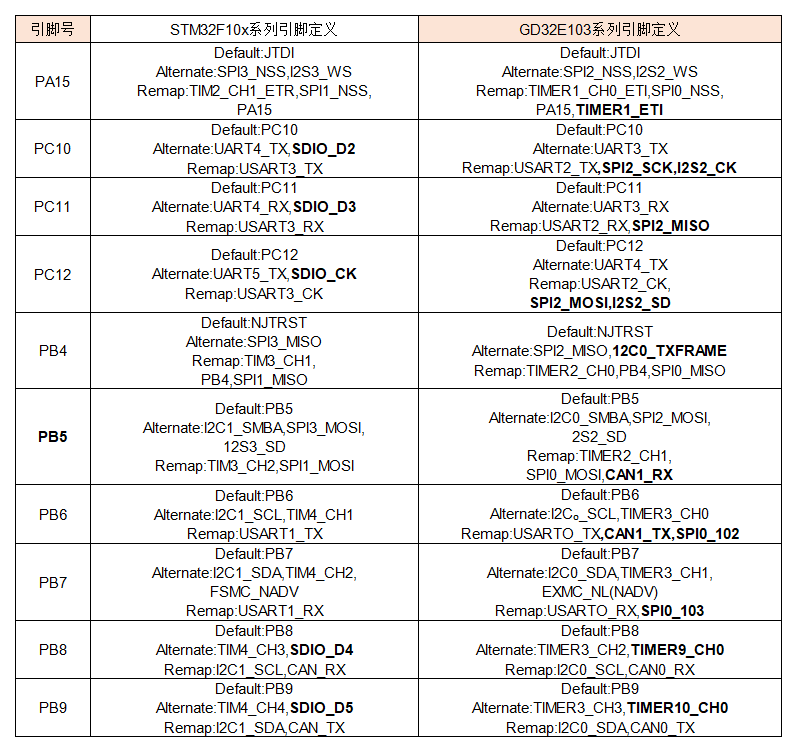
3. 內(nèi)部資源兼容性
下表給出了 STM32F10x 與 GD32E103 的資源對比總覽(以 STM32F103V8、STM32F105V8 和GD32E103V8 對比為例):
表 2 STM32F105 系列和 GD32E103 系列內(nèi)部資源對比總覽
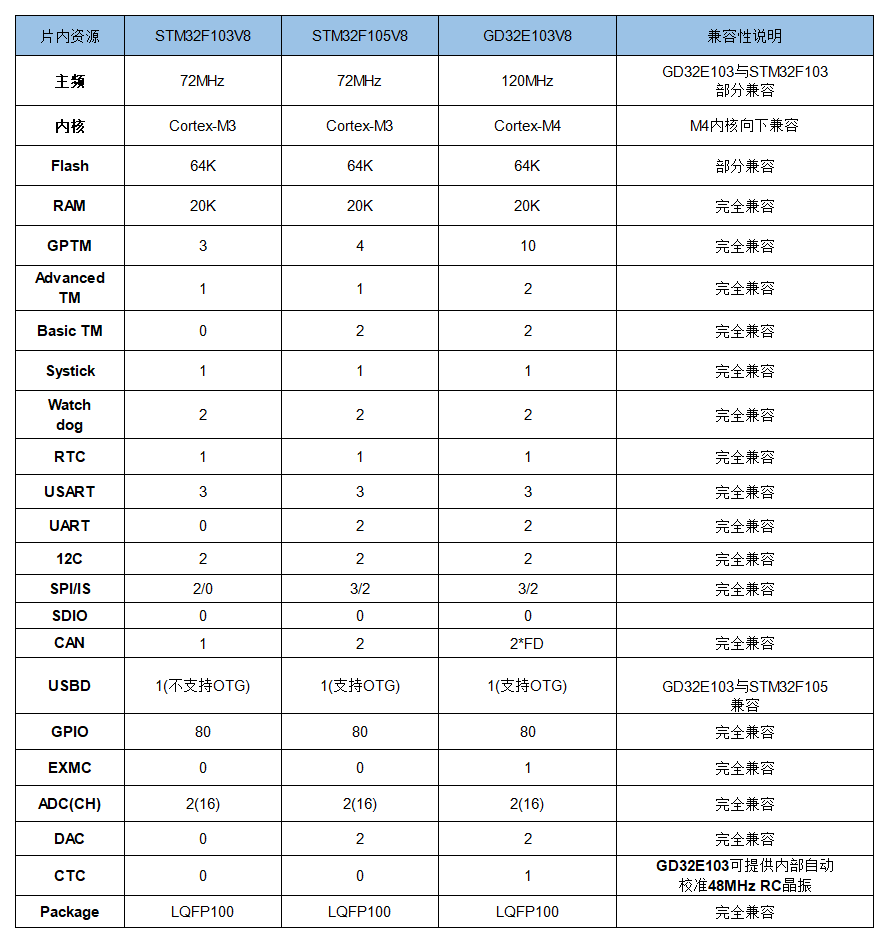
4. 程序移植
4.1 時鐘移植
GD32E103 時鐘設(shè)置與 STM32F10x 互聯(lián)系列兼容,如從 STM32F103 移植到 GD32E103,IDE 需要做相關(guān)調(diào)整,具體過程如下:
(1) 使用 MDK 環(huán)境時:
在工程選項 C/C++選項卡中 Preprocessor Symbol Define 中加入 GD32F10X_CL 的宏定義;在工程選項 Device 中選擇原 MCU 對應(yīng)的互聯(lián)性型號,或?qū)?yīng)的 GD32E103 型號。
(2) 使用 IAR 環(huán)境時:
在 工 程 選 項 C/C++ Compiler 項 中 Preprocessor 選項卡下 Define Symbol 中加入GD32F10X_CL 的宏定義。
在工程選項 Device 中選擇原 MCU 對應(yīng)的互聯(lián)性型號,或?qū)?yīng)的 GD32E103 型號。
4.2 Flash 操作相關(guān)軟件移植
4.2.1 FLash 編程操作
STM32F10x 系列 MCU 僅支持 16 位半字編程,而 GD32E103 僅支持 32 位字和 64 位雙字編程,所以需要對 Flash 編程相關(guān)庫函數(shù)進(jìn)行更改。
(1) FLASH_ProgramWord 函數(shù)
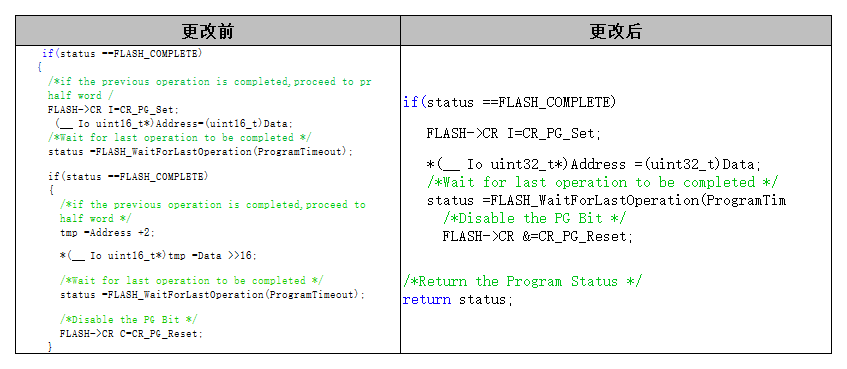
說明:由原來的兩次半字編程改為一次字編程。
(2) FLASH_EnableWriteProtection 函數(shù)
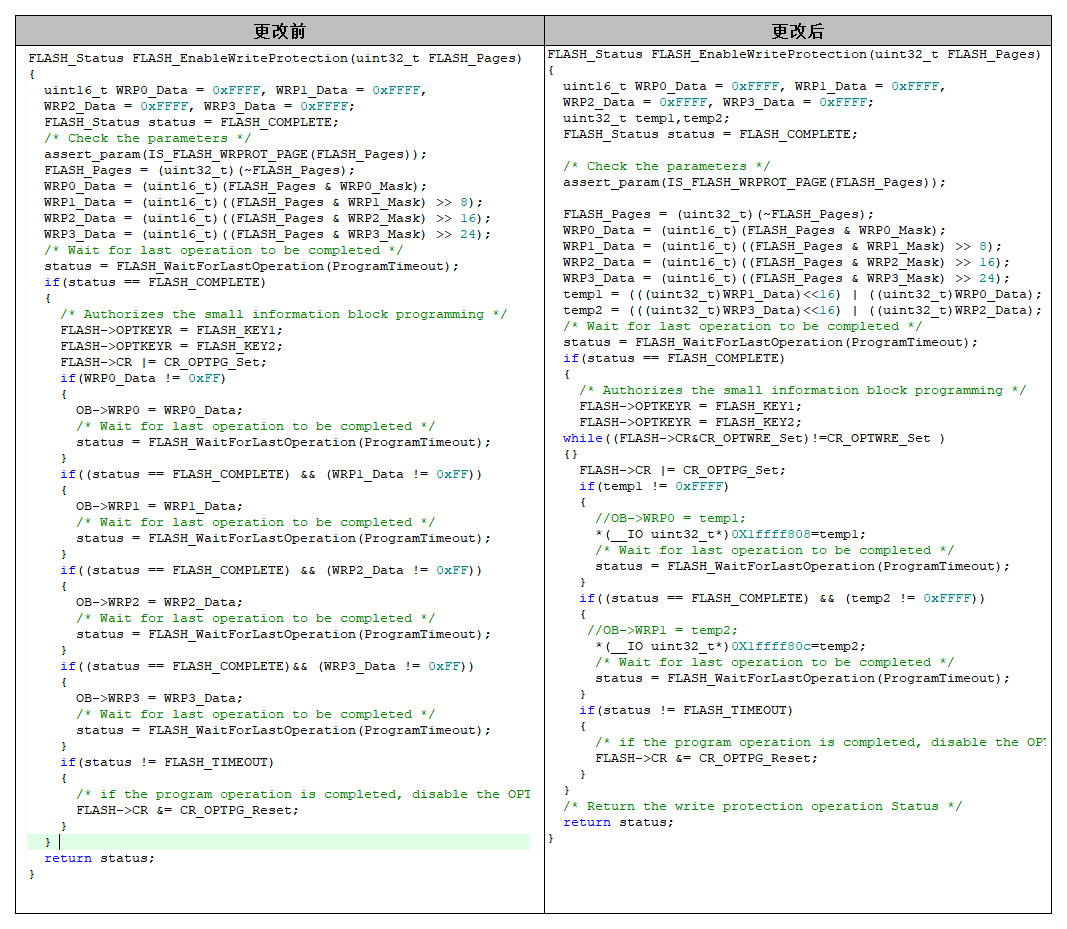
(3) FLASH_ProgramOptionByteData 函數(shù)
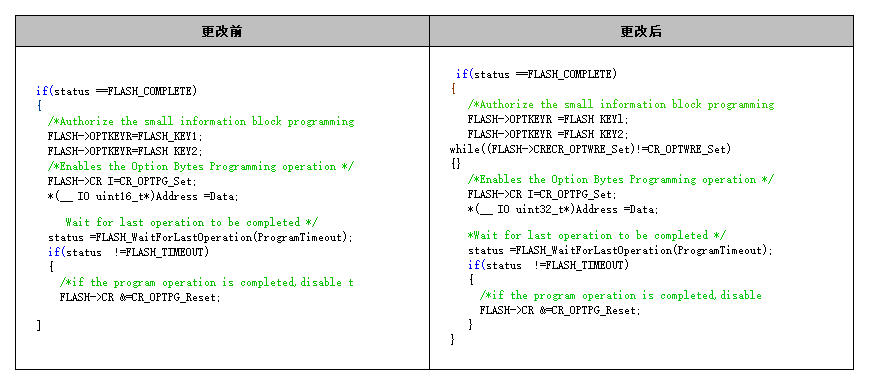
說明:由原來的半字編程改為字編程,用戶需注意,選項字節(jié)需至少一次寫一個字,且目標(biāo)地址必須是 4 的
整數(shù)倍。
(4) FLASH_EraseOptionBytes 函數(shù)
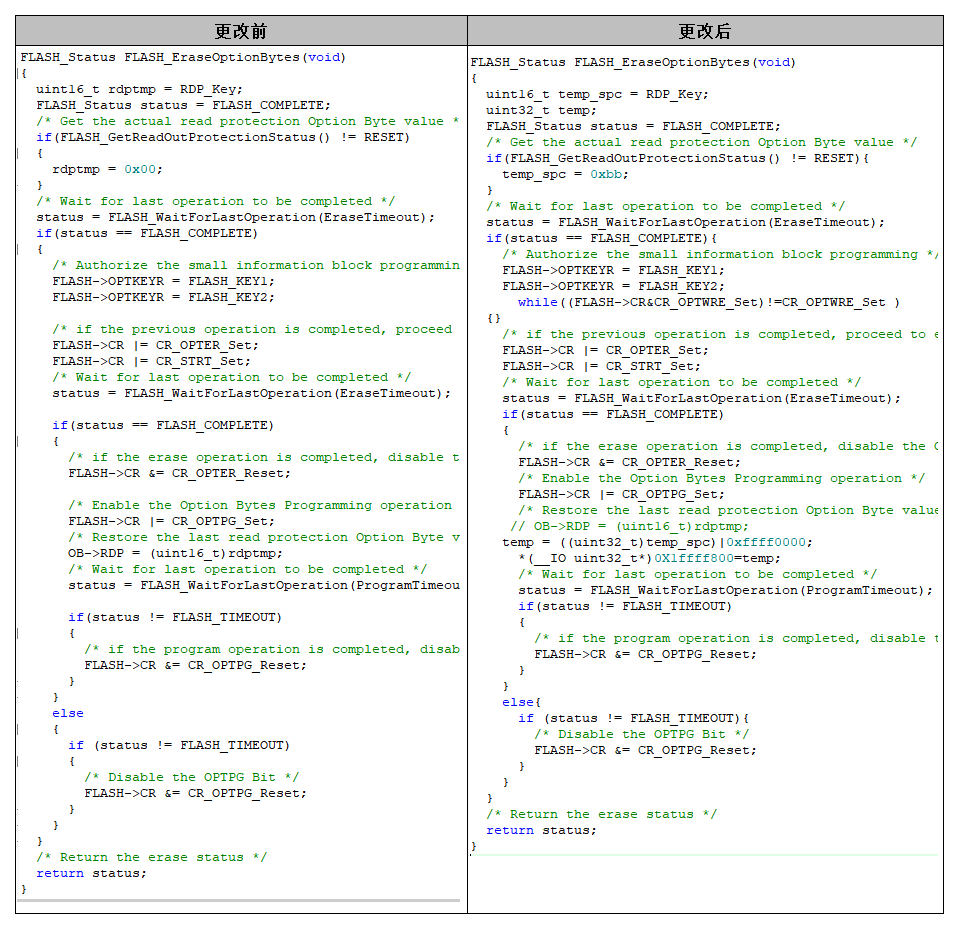
(5) FLASH_ReadOutProtection 函數(shù)
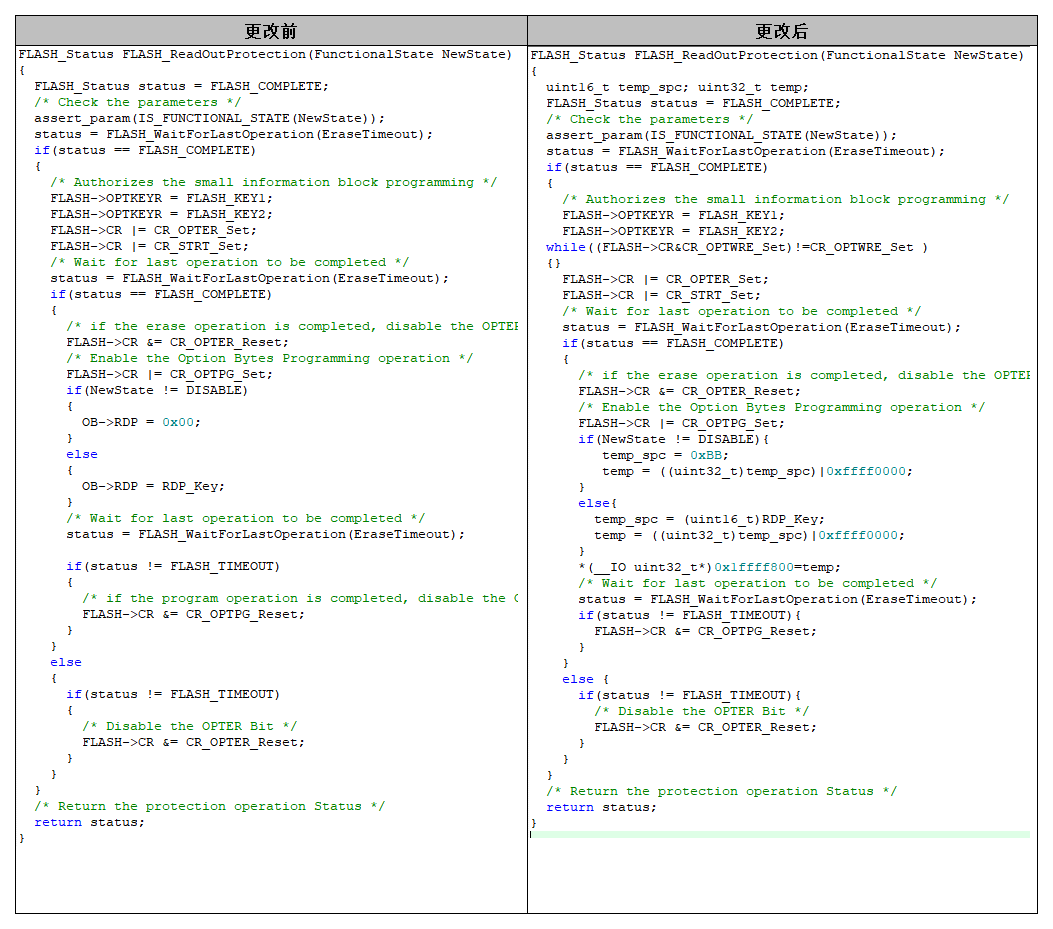
(6) FLASH_UserOptionByteConfig 函數(shù)
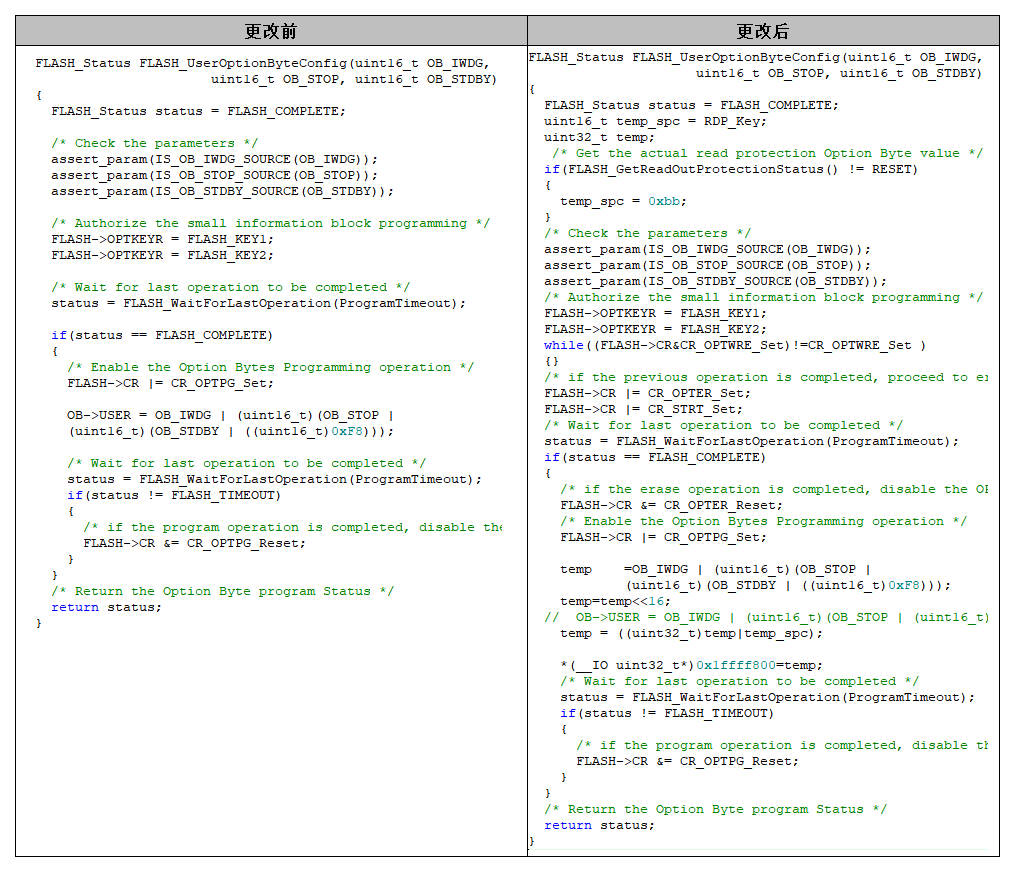
注:以上代碼中的 CR_OPTWRE_Set 的定義是 STM32 固件庫中沒有的,需要用戶自行定義為:
#define CR_OPTWRE_Set ((uint32_t)0x00000200)
4.2.2 注意事項
STM32F10x 的互聯(lián)型和大容量型(因為 GD32E103 沒有大容量型,所以可不考慮)的 Flash 閃存頁大小為 2K,而 GD32E103 為 1K,所以用戶在調(diào)用頁擦除時要注意頁地址范圍。
5. 外設(shè)差異性
STM32F10x 與 GD32E103 在外設(shè)上基本是兼容的,但 GD32E103 較 STM32F10x 在很多外設(shè)上增加了部分功能,用戶可根據(jù)以下羅列出的外設(shè)差異性選擇是否使用這些功能。
5.1 模數(shù)轉(zhuǎn)換器 ADC
為減輕 CPU 的負(fù)擔(dān),GD32E103 較 STM32F10x 增加了片上硬件過采樣單元。它能夠處理多個轉(zhuǎn)換,并將多個轉(zhuǎn)換的結(jié)果取平均,得出一個 16 位寬的數(shù)據(jù)。 片上硬件過采樣單元是以降低數(shù)據(jù)輸出率為代價,換取較高的數(shù)據(jù)分辨率。 具體功能以及寄存器設(shè)置,請用戶參考 GD32E10x 用戶
手冊。
另外,由于兩款芯片的在 ADC 設(shè)計上的差異性,在移植到 GD32E103 時,ADC 使能之后,校準(zhǔn)之前,需加入 1ms 的延時,以便 ADC 穩(wěn)定后再進(jìn)行校準(zhǔn)。
5.2 通用同步異步收發(fā)器 USART
GD32E103 較 STM32F10x 在 USART 上增加了塊模式(STM32F10x 只支持字節(jié)模式)、數(shù)據(jù)極性設(shè)置、數(shù)據(jù)位反轉(zhuǎn)以及 TX、RX 引腳電平反轉(zhuǎn)等功能,因此,GD32E103 多了四個寄存器,分別為:USART_CTL3、USART_RT、USART_STAT1、USART_CHC。具體功能以及寄存器設(shè)置,請用戶參考 GD32E10x 用戶手冊。
5.3 內(nèi)部集成電路總線接口 I2C
GD32E103和STM32F10x的I2C都支持標(biāo)速(最高100KHz)和快速(最高400KHz),同時GD32E103可支持高速模式(最高 1MHz),要使能高速模式,需將 I2C_FMPCFG 寄存器的 FMPEN 置 1。具體功能以及寄存器設(shè)置,請用戶參考 GD32E10x 用戶手冊。
5.4 串行外設(shè)接口/片上音頻接口 SPI/I2S
GD32E103 和 STM32F10x 的 SPI/I2S 模塊差異性主要表現(xiàn)在 GD32E103 支持 SPI TI 模式、SPI NSS 脈沖模式和 SPI 四線功能(只有 SPI1),其中 SPI 的四線模式是用于控制四線 SPI Flash 外設(shè),此模式下,數(shù)據(jù)傳輸速率是普通模式下的 4 倍。具體功能以及寄存器設(shè)置,請用戶參考 GD32E10x 用戶手冊。
5.5 通用串行總線全速設(shè)備接口 USBFS
GD32E103 和 STM32F105/107 的 USBFS 一致,同時 GD32E103 較 STM32F105/107 相比多了IRC48M 的時鐘源可選擇。具體功能以及寄存器設(shè)置,請用戶參考 GD32E103 用戶手冊。
GD32E103 和 STM32F103 的 USB 模塊是不兼容的,如果用戶是從 STM32F103 移植而來,需要進(jìn)行代碼移植,具體請參考 STM32F103 與 STM32F105/107 的 USB 差異性。
6. 附錄:
(Flash 更改后的程序,用戶可直接復(fù)制替換原庫函數(shù))
0、在 stm32f10x_flash.c 中添加
#define CR_OPTWRE_Set ((uint32_t)0x00000200)
1、
FLASH_Status FLASH_ProgramWord(uint32_t Address, uint32_t Data) { FLASH_Status status = FLASH_COMPLETE; __IO uint32_t tmp = 0; /* Check the parameters */ assert_param(IS_FLASH_ADDRESS(Address)); /* Wait for last operation to be completed */ status = FLASH_WaitForLastOperation(ProgramTimeout); if(status == FLASH_COMPLETE) { FLASH->CR |= CR_PG_Set; *(__IO uint32_t*)Address = (uint32_t)Data; /* Wait for last operation to be completed */ status = FLASH_WaitForLastOperation(ProgramTimeout); /* Disable the PG Bit */ FLASH->CR &= CR_PG_Reset; } /* Return the Program Status */ return status; }
2、
FLASH_Status FLASH_EnableWriteProtection(uint32_t FLASH_Pages) { uint16_t WRP0_Data = 0xFFFF, WRP1_Data = 0xFFFF, WRP2_Data = 0xFFFF, WRP3_Data = 0xFFFF; uint32_t temp1,temp2; FLASH_Status status = FLASH_COMPLETE; /* Check the parameters */ assert_param(IS_FLASH_WRPROT_PAGE(FLASH_Pages)); FLASH_Pages = (uint32_t)(~FLASH_Pages); WRP0_Data = (uint16_t)(FLASH_Pages & WRP0_Mask); WRP1_Data = (uint16_t)((FLASH_Pages & WRP1_Mask) >> 8); WRP2_Data = (uint16_t)((FLASH_Pages & WRP2_Mask) >> 16); WRP3_Data = (uint16_t)((FLASH_Pages & WRP3_Mask) >> 24); temp1 = (((uint32_t)WRP1_Data)<<16) | ((uint32_t)WRP0_Data); temp2 = (((uint32_t)WRP3_Data)<<16) | ((uint32_t)WRP2_Data); /* Wait for last operation to be completed */ status = FLASH_WaitForLastOperation(ProgramTimeout); if(status == FLASH_COMPLETE) { /* Authorizes the small information block programming */ FLASH->OPTKEYR = FLASH_KEY1; FLASH->OPTKEYR = FLASH_KEY2; while((FLASH->CR&CR_OPTWRE_Set)!=CR_OPTWRE_Set ) {} FLASH->CR |= CR_OPTPG_Set; if(temp1 != 0xFFFF) { //OB->WRP0 = temp1; *(__IO uint32_t*)0X1ffff808=temp1; /* Wait for last operation to be completed */ status = FLASH_WaitForLastOperation(ProgramTimeout); } if((status == FLASH_COMPLETE) && (temp2 != 0xFFFF)) { //OB->WRP1 = temp2; *(__IO uint32_t*)0X1ffff80c=temp2; /* Wait for last operation to be completed */ status = FLASH_WaitForLastOperation(ProgramTimeout); } if(status != FLASH_TIMEOUT) { /* if the program operation is completed, disable the OPTPG Bit */ FLASH->CR &= CR_OPTPG_Reset; } } /* Return the write protection operation Status */ return status; }
3、
FLASH_Status FLASH_ProgramOptionByteData(uint32_t Address, uint32_t Data) { FLASH_Status status = FLASH_COMPLETE; /* Check the parameters */ assert_param(IS_OB_DATA_ADDRESS(Address)); status = FLASH_WaitForLastOperation(ProgramTimeout); if(status == FLASH_COMPLETE) { /* Authorize the small information block programming */ FLASH->OPTKEYR = FLASH_KEY1; FLASH->OPTKEYR = FLASH_KEY2; while((FLASH->CR&CR_OPTWRE_Set)!=CR_OPTWRE_Set ) {} /* Enables the Option Bytes Programming operation */ FLASH->CR |= CR_OPTPG_Set; *(__IO uint32_t*)Address = Data; /* Wait for last operation to be completed */ status = FLASH_WaitForLastOperation(ProgramTimeout); if(status != FLASH_TIMEOUT) { /* if the program operation is completed, disable the OPTPG Bit */ FLASH->CR &= CR_OPTPG_Reset; } } /* Return the Option Byte Data Program Status */ return status; }
4、
FLASH_Status FLASH_EraseOptionBytes(void) { uint16_t temp_spc = RDP_Key; uint32_t temp; FLASH_Status status = FLASH_COMPLETE; /* Get the actual read protection Option Byte value */ if(FLASH_GetReadOutProtectionStatus() != RESET){ temp_spc = 0xbb; } /* Wait for last operation to be completed */ status = FLASH_WaitForLastOperation(EraseTimeout); if(status == FLASH_COMPLETE){ /* Authorize the small information block programming */ FLASH->OPTKEYR = FLASH_KEY1; FLASH->OPTKEYR = FLASH_KEY2; while((FLASH->CR&CR_OPTWRE_Set)!=CR_OPTWRE_Set ) {} /* if the previous operation is completed, proceed to erase the option bytes */ FLASH->CR |= CR_OPTER_Set; FLASH->CR |= CR_STRT_Set; /* Wait for last operation to be completed */ status = FLASH_WaitForLastOperation(EraseTimeout); if(status == FLASH_COMPLETE) { /* if the erase operation is completed, disable the OPTER Bit */ FLASH->CR &= CR_OPTER_Reset; /* Enable the Option Bytes Programming operation */ FLASH->CR |= CR_OPTPG_Set; /* Restore the last read protection Option Byte value */ // OB->RDP = (uint16_t)rdptmp; temp = ((uint32_t)temp_spc)|0xffff0000; *(__IO uint32_t*)0X1ffff800=temp; /* Wait for last operation to be completed */ status = FLASH_WaitForLastOperation(ProgramTimeout); if(status != FLASH_TIMEOUT) { /* if the program operation is completed, disable the OPTPG Bit */ FLASH->CR &= CR_OPTPG_Reset; } } else{ if (status != FLASH_TIMEOUT){ /* Disable the OPTPG Bit */ FLASH->CR &= CR_OPTPG_Reset; } } } /* Return the erase status */ return status; }
5、
FLASH_Status FLASH_ReadOutProtection(FunctionalState NewState) { uint16_t temp_spc; uint32_t temp; FLASH_Status status = FLASH_COMPLETE; /* Check the parameters */ assert_param(IS_FUNCTIONAL_STATE(NewState)); status = FLASH_WaitForLastOperation(EraseTimeout); if(status == FLASH_COMPLETE) { /* Authorizes the small information block programming */ FLASH->OPTKEYR = FLASH_KEY1; FLASH->OPTKEYR = FLASH_KEY2; while((FLASH->CR&CR_OPTWRE_Set)!=CR_OPTWRE_Set ) {} FLASH->CR |= CR_OPTER_Set; FLASH->CR |= CR_STRT_Set; /* Wait for last operation to be completed */ status = FLASH_WaitForLastOperation(EraseTimeout); if(status == FLASH_COMPLETE) { /* if the erase operation is completed, disable the OPTER Bit */ FLASH->CR &= CR_OPTER_Reset; /* Enable the Option Bytes Programming operation */ FLASH->CR |= CR_OPTPG_Set; if(NewState != DISABLE){ temp_spc = 0xBB; temp = ((uint32_t)temp_spc)|0xffff0000; } else{ temp_spc = (uint16_t)RDP_Key; temp = ((uint32_t)temp_spc)|0xffff0000; } *(__IO uint32_t*)0x1ffff800=temp; /* Wait for last operation to be completed */ status = FLASH_WaitForLastOperation(EraseTimeout); if(status != FLASH_TIMEOUT){ FLASH->CR &= CR_OPTPG_Reset; } } else { if(status != FLASH_TIMEOUT){ /* Disable the OPTER Bit */ FLASH->CR &= CR_OPTER_Reset; } } } /* Return the protection operation Status */ return status; }
6、
FLASH_Status FLASH_UserOptionByteConfig(uint16_t OB_IWDG,uint16_t OB_STOP, uint16_t OB_STDBY) { FLASH_Status status = FLASH_COMPLETE; uint16_t temp_spc = RDP_Key; uint32_t temp; /* Get the actual read protection Option Byte value */ if(FLASH_GetReadOutProtectionStatus() != RESET) { temp_spc = 0xbb; } /* Check the parameters */ assert_param(IS_OB_IWDG_SOURCE(OB_IWDG)); assert_param(IS_OB_STOP_SOURCE(OB_STOP)); assert_param(IS_OB_STDBY_SOURCE(OB_STDBY)); /* Authorize the small information block programming */ FLASH->OPTKEYR = FLASH_KEY1; FLASH->OPTKEYR = FLASH_KEY2; while((FLASH->CR&CR_OPTWRE_Set)!=CR_OPTWRE_Set ) {} /* if the previous operation is completed, proceed to erase the option bytes */ FLASH->CR |= CR_OPTER_Set; FLASH->CR |= CR_STRT_Set; /* Wait for last operation to be completed */ status = FLASH_WaitForLastOperation(ProgramTimeout); if(status == FLASH_COMPLETE) { /* if the erase operation is completed, disable the OPTER Bit */ FLASH->CR &= CR_OPTER_Reset; /* Enable the Option Bytes Programming operation */ FLASH->CR |= CR_OPTPG_Set; temp =OB_IWDG | (uint16_t)(OB_STOP | (uint16_t)(OB_STDBY | ((uint16_t)0xF8))); temp=temp<<16; temp = ((uint32_t)temp|temp_spc); *(__IO uint32_t*)0x1ffff800=temp; /* Wait for last operation to be completed */ status = FLASH_WaitForLastOperation(ProgramTimeout); if(status != FLASH_TIMEOUT) { /* if the program operation is completed, disable the OPTPG Bit */ FLASH->CR &= CR_OPTPG_Reset; } } /* Return the Option Byte program Status */ return status; }
本教程由GD32 MCU方案商聚沃科技原創(chuàng)發(fā)布,了解更多GD32 MCU教程,關(guān)注聚沃科技官網(wǎng)
-
單片機
+關(guān)注
關(guān)注
6039文章
44582瀏覽量
636481 -
嵌入式
+關(guān)注
關(guān)注
5087文章
19147瀏覽量
306155 -
STM32
+關(guān)注
關(guān)注
2270文章
10910瀏覽量
356599 -
開發(fā)板
+關(guān)注
關(guān)注
25文章
5082瀏覽量
97708 -
GD32
+關(guān)注
關(guān)注
7文章
404瀏覽量
24384
發(fā)布評論請先 登錄
相關(guān)推薦
【GD32 MCU 移植教程】1、從 GD32F10x 移植到 GD32F30x
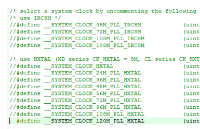
AN047 GD32E103&C103移植到GD32F30x
AN011 GD32F10x系列移植到GD32F30x系列
【GD32 MCU 移植教程】2、從 GD32F303 移植到 GD32F503
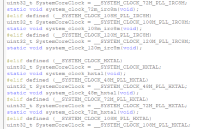
【GD32 MCU 移植教程】7、從 GD32F10x 移植到 GD32E103
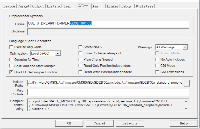
【GD32 MCU 移植教程】8、從 STM32F4xx 系列移植到 GD32F4xx 系
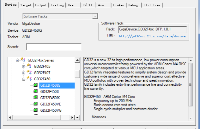
【GD32 MCU 移植教程】9、從 STM32F10x 系列移植到 GD32F30x 系列
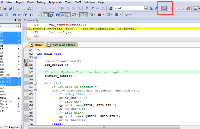
【GD32 MCU 移植教程】10、從STM32F030系列移植到GD32E230系列





 【GD32 MCU 移植教程】3、從 STM32F10x 移植到 GD32E103 的移植說明
【GD32 MCU 移植教程】3、從 STM32F10x 移植到 GD32E103 的移植說明

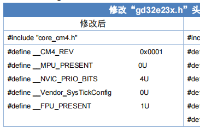
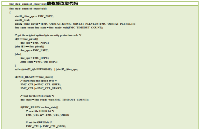










評論